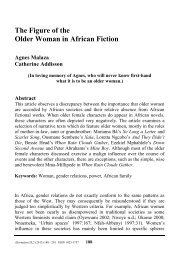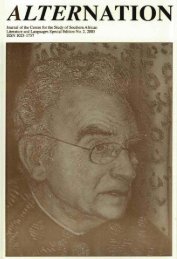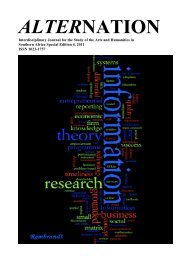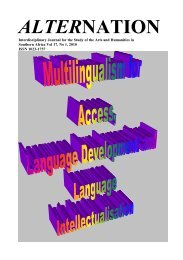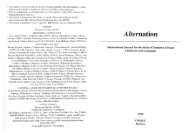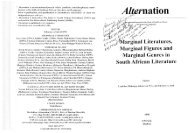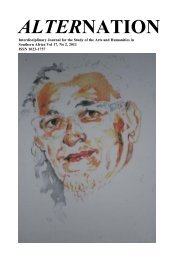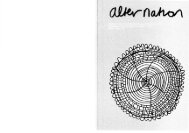Shane Moran - Alternation Journal
Shane Moran - Alternation Journal
Shane Moran - Alternation Journal
Create successful ePaper yourself
Turn your PDF publications into a flip-book with our unique Google optimized e-Paper software.
y Janua~y 1957. intelligence reports liad it that peasants in Central Kenya were<br />
iuhispering and talking about a man called Matigari \vho was roaming the wliolc<br />
country making de~na~ids about truth and justice.<br />
Although the reports soon made clear that the figure was more fictional than real, the<br />
confiscation of all copies ofthe novel still took place the following month. Because the<br />
novel was deemed to be subversive, and beca~lse its central character had apparently the<br />
power to infiltrate even the enclosed and impoverished areas of the Kenyan<br />
countryside, it had to be repressed. Of course, however hard the government might tly<br />
to eradicate or make negligible the story of Matigari, its efforts to eliminate the text<br />
from popular consciousness entirely must be regarded as a failure; a failure because its<br />
existence as a written text had already been bypassed, and because its new life as an oral<br />
document had been absorbed within those communities most likely to benefit from its<br />
message within a relatively short period. 111 Ngugi's scheme of things, the power to<br />
move beyond the confines of the literate, to free up and publicise an account of<br />
revolutionary challenge without having to rely on the transfer of the printed word is not<br />
only the best answer to chronic and widespread illiteracy, but to the repressive measures<br />
of state supervision and censorship.<br />
Ngugi strives for a text that, because of its i~nmediate accessibility as a Gikuyu<br />
published novel, achieves greater political renown than if it were to be only published in<br />
English. In addition, the popular and easy appropriation of the text, the sense that its<br />
characters and their various difficulties can be widely discussed, suggests a text that has<br />
taken on a distinct life, one that has drawn from, and is now drawn back into, oral<br />
tradition. For instance, in the opening pages of Matigari one is introduced to a scene in<br />
which a sense of locale and history is established, and in which a central character,<br />
developed through the use of highly rhetorical language and motifs, is clearly<br />
presented. Emphasis is kept on the physicality of the man through a set of detailed and<br />
visualised descriptions, while the physical landscape is either subordinated or well<br />
muted. In keeping with the almost reverential quality of the scene, and as an effective<br />
method of drawing attention to the details of transformation and arrival, an effective<br />
silence is consistently maintained. The third person narration, in the ideal story-telling<br />
position, simply docuinents the scene, taking care to einphasise the i~nportance of<br />
water, initiation procedures, and the quest for a sense of belonging.<br />
But how does Ngugi invite his audience to elnpathise with this, and in what<br />
way can the story be told so as to allow For further, publlc retellings? Perhaps one of the<br />
most engaging methods of directly involving an audience is to ask questions; not direct<br />
questions, but rhetorical ones, such as can be found at the end of the first and second<br />
sections of the text. For example at the end of section one the narrator suggests that<br />
'from that night, Matigari's fame spread over all the country. He became a legend. He<br />
became a dream. Still the question remained: Who was Matigari ma Njiruungu?'<br />
(Ngugi 1987:66). At the close ofthe second section we are told of how<br />
the songs spread like wildfire in a dry season. ?'hey spread through the<br />
villages. The people sang them day and night .... They wouldsing the song of<br />
Matigari ma Njiruungi .... But who was Matigari ma Njiruungu? (Ngugi<br />
Ngzlgl's Matgal I and tlze Polltics ofl,iteratz/re<br />
These questiotls may well have the effect of simply retaining interest, or of tying the<br />
various strands of the story together in ways that I have already discussed, but they also<br />
invite a form of interrogative and participatory involvement where the audience is<br />
concerned. And something of this technique is established in the opening scenes also,<br />
techniques that challenge and provoke the audience, thereby drawing them directly into<br />
the lext. 117 other words, even where Ngugi presents one voice or one set of<br />
psycl?ological considerations within the text, he still invites others to contributex. At<br />
other times he simply establishes a democratic, non-hierarchical stlilcture by providi~lg<br />
Itiple, frequently competing, voices; for example in the way that he uses radio<br />
uences not only to heighten tensio~l but to provide additional cornmeiltary from<br />
ernative perspectives. By splitting his narrative up, by creating a sense ofwhat Derek<br />
ight (1992:86), in a discussion of Armah's Two Tho~isclnd Se~isons has called<br />
'traditional communal intimacy', Ngugi builds oral structures directly into the text. Of<br />
course this was a strategy he had attempted with Petals also. with various characters<br />
taking it in turn to discuss their experiences, each experience seen as a uniquely<br />
articulated moment that would eventually collect around a central idea. But the process<br />
within M~rtigari, I think, is a much more developed and structurally intrinsic aspect of<br />
~irect appeals to story-telling and to its hypnotic, in some cases<br />
transhistoricising power, run throughout the novel:<br />
'Thcman'seyes shonc brightly. His melodious voice and his story liad been so<br />
captivating that Muriuki and Ngaruro wa Kiriro did not rcalise that they had<br />
reached the restaurant. His story had so transported thein to other times long<br />
ago when the clashing or the warrior's bows and spears sllook trces and<br />
nlountains to tlieir roots (Ngugi 1987:221).<br />
In this particular instance story-telling would seem to be capable of reach~ng into the<br />
past, suggestmg a continuity of resistance, in addition to provid~ng a vehicle for<br />
stateinelits of solidarity and colninunal feeling. In addition, Ngugl's deliberate<br />
referencing to an active and tribally unified opposttion might be seen as a means of<br />
showing how politically repressed individuals can be successfUlly motivated by the use<br />
of story-telling techniques At a more practical level, however, the activity of storytelling<br />
prepares the ground for the text's direct (re)introduction into oral culture. The<br />
easy identification made between the text and oral tradition helps define the novei as<br />
directly amenable to a story-telling environment and gives it a more performative<br />
'In order for the [Keuyanl students to Sully appreciate the gc111.c. we cncouragcd them to<br />
fully participate in any perrormances that they canic across. This lielpecl tlic~n io ~~~icler-stand lio~v<br />
the audience can shape tlie narrative, and how time cw help an artist to niake an otlierwise s1rol.t<br />
narrative into a long complex one' (Adagala& Kabi1.a l985:80).



